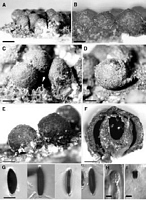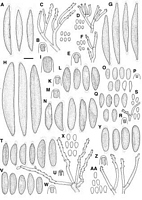|
 Rosellinia samuelsii Rosellinia samuelsii
BiostatusPresent in region - Indigenous. Endemic
Images (click to enlarge)
Caption: Fig. 27 Rosellinia samuelsii.
A-E, Stromata, C showing synnemata (arrow); F, Vertical section of stroma, note
stroma shell
and detached perithecium; G, Ascospores, 2nd to 4th | 
Caption: Fig. 8 A-D, Rosellinia arcuata, PDD 41969: A, Ascospores; B, Ascus apical ring; C,
Conidiophores and conidia on the host; D, Conidiophores and conidia on OA; E-G, R.
freycinetiae, PDD 20580: E, Ascus a |
Article: Petrini, L.E. (2003). Rosellinia and related genera in New Zealand. New Zealand Journal of Botany 41(1): 71-138 (http://www.rsnz.org/publish/abstracts.php).
Description: Subiculum persistent, dark brown, wiry, partially without stromata but with many synnemata.
Stromata (1050)1160 ± 125(1375) µm high, (1125)1245 ± 99(1300) µm wide (n = 5),
globose, with a short broad cylindrical base, copper brown, black around the ostioles, with
rugose to wrinkled surfaces, solitary to crowed, becoming laterallycompressed. Ostioles
coarsely papillate. Ectostroma 75-100 µm thick, black, hard, splintering. Entostroma cream,
later dark brown, confined to base, absent in mature material. Perithecia detached and
collapsed in mature material. Ascus apical rings (6.7)7.3 ± 0.5(7.6) µm long, upper width
4.5-5 µm, lower width 3.5-4 µm (n = 5), J+, dark blue. Ascospores (21.6)23.3 ± 1.4(26.9) µm
long, (6.7)7.7 ± 0.5(8.6) µm wide (n = 30), inequilaterally ellipsoidal, brown to dark brown,
with 10-13 µm long straight germ slit centred on the flat side, both extremities and the flat
side surrounded by a slimy sheath, up to 4.5 x 3-4 µm thick at the ends, 1 µm thick at side.
Synnemata up to 650 µm high. Conidia 6-10 x 3-4 µm.
ANAMORPH: Dematophora.
Habitat: HOST: Undetermined hardwood.
MATRIX: Decorticated wood.
Notes: ETYMOLOGY: In honour of the mycologist G. Samuels who collected and cultured many of
the Rosellinia specimens deposited at PDD.
NOTES: Rosellinia samuelsii combines characters of massive stromata, flattened, ellipsoidal
ascospores with a short germ slit and a Dematophora anamorph. Many fertile synnemata are
present in parts of the subiculum devoid of stromata.
Rosellinia samuelsii differs from R. hughesii by its larger stromata and larger ascospores with
a short germ slit, and from R. buxi by a thinner ectostroma, larger ascus apical rings,
ascospores surrounded partially by a slimy sheath and shorter germ slits, as well as larger
conidia (Petrini 1993). Rosellinia paraguayensis Starbäck and R. petrakii Narendra have
similarly shaped but larger ascospores than R. samuelsii. Rosellinia paraguayensis has also a
Dematophora anamorph, in contrast to R. petrakii.
Rosellinia britannica has ascospores of similar size, but it differs from R. samuelsii by the
smaller stromata of a different shape, an evanescent subiculum with a Geniculosporium
anamorph, and ascospores with a longer germ slit (Petrini et al. 1989).
|